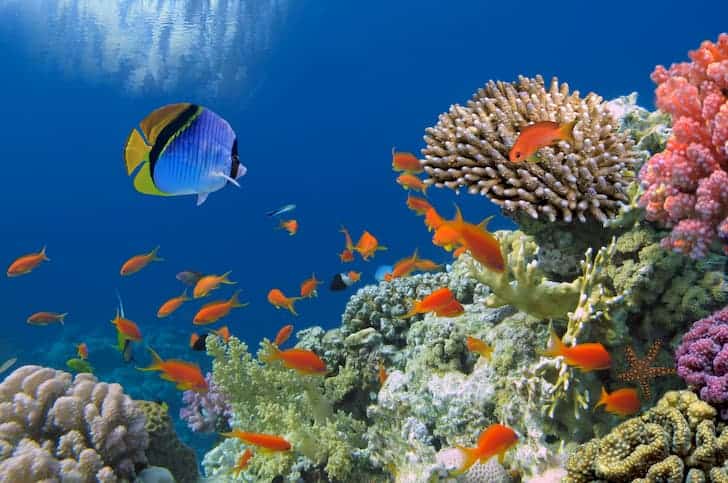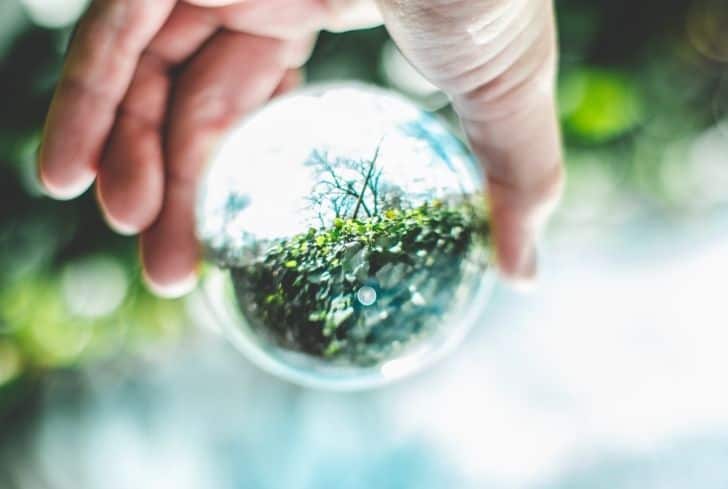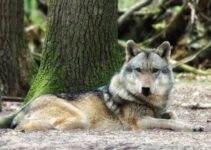Biodiversity or Biological diversity is a term that describes the variety of living beings on earth. In short, it is described as a degree of variation of life. Biological diversity encompasses microorganisms, plants, animals, and ecosystems, such as coral reefs, forests, rainforests, deserts, etc.
Biodiversity also refers to the number or abundance of different species living within a particular region. It represents the wealth of biological resources available to us. It’s all about sustaining the natural area made up of a community of plants, animals, and other living things that is being reduced at a steady rate as we plan human activities that are being reduced by habitat destruction.
Photo by: DepositPhotos
If we pollute the air, water and soil that keep us alive and well, and destroy the biodiversity that allows natural systems to function, no amount of money will save us.
~ David Suzuki
The United Nations designated 2011–2020 as the United Nations Decade on Biodiversity. In biodiversity, each species, no matter how big or small, has an important role to play in the ecosystem. Various plant and animal species depend on each other for what each offer, and these diverse species ensure natural sustainability for all life forms. Healthy and solid biodiversity can recover from a variety of disasters.
Biodiversity has three essential elements:
- Genetic diversity,
- Ecosystem diversity and
- Species diversity
Recently a new aspect has also been added- ‘molecular diversity’.
Biodiversity is unevenly distributed. It varies globally and within regions. The various factors that influence biodiversity include -temperature, altitude, precipitation, soils, and their relation with other species. For instance, ocean biodiversity is 25 times lesser than terrestrial diversity. Biodiversity also increases its form as it moves from the poles towards the tropics.
Biodiversity is the result of 3.5 billion years of evolution. It has been subject to periods of extinction. The latest and most destructive stage of extinction is Holocene extinction, which has occurred due to the impact of human beings on the environment.
Why is Biodiversity Important?
The role of biodiversity in the following areas will help make clear the importance of biodiversity in human life:
1. Biodiversity Offers a Number of Natural Services
We humans depend on a number of natural services offered by ecosystems to live a healthy life on the Earth. They are as follows.
- Maintaining The Balance of The Ecosystem: Recycling and storage of nutrients, combating pollution by breaking it down and its absorption, stabilizing climate, protecting water resources, forming and protecting soil, recovery from unpredictable events and maintaining overall eco-balance.
- Provision of Biological Resources: Provision of medicines and pharmaceuticals, food for the human population and animals, ornamental plants, wood products, breeding stock, future resources and diversity of species, ecosystems, and genes.
- Social Benefits: Recreation and tourism, cultural value and education, research and monitoring.
2. Biodiversity and Food
Biodiversity provides for a variety of foods for the planet. Because of the availability of different species, humans are able to obtain a range of materials and foods to support their well-being and health.
The various foods such as fish, meat, vegetables, fruits, and cereals are all available because of the planet’s biodiversity. 80% of the human food supply comes from 20 kinds of plants. But humans use 40,000 species for food, clothing, and shelter.
3. Biodiversity and Human Health
Biodiversity also plays an essential role in drug discovery and medicinal resources. Through biological diversity, scientists have made significant advances in medical discoveries and have found cures for several diseases.
All this has been possible because of research into the various animal and plant genetics as well as biology. 80% of vaccines and drugs used in prevention and treatment respectively are from the world’s biodiversity. Medicines from nature account for usage by 80% of the world’s population.
4. Keeping Bio-Diverse Ecosystems Intact Helps Humans Stay Healthy
Research indicates that there is a close link between disease outbreaks and the degradation of nature.
As the global wildlife trade continues and development projects expand deeper into tropical forests, humans are increasing their exposure to wild animals and the diseases they may carry. Seventy percent of emerging viral diseases have spread from animals to humans.
For example, the COVID-19 pandemic can likely be sourced to a wild animal and fish market in Wuhan, China. With COVID-19, we’ve seen the damage that diseases can do not only to human health but also to the global economy.
Deforestation is also accelerating climate breakdown, which in turn may boost the spread of disease by allowing disease carriers like mosquitoes to extend their geographic ranges and infect new populations of humans.
This shows that we must take care of nature to take care of ourselves. By protecting biodiversity in Earth’s ecosystems, countries could save lives and money, while helping to prevent future pandemics.
5. Continuity of Planet and Balance of the Ecosystem
Biodiversity plays an important role in offering ecological services that make life livable on Earth. The ecological balance and biodiversity are crucial for all of the earth, not just humans.
The ecological services include air purification, replenishing and cleaning water systems, absorbing chemicals and breaking down pollutants, stabilizing climate, recycling nutrients and storage, forming and protecting the soil and speedy recovery from natural disasters. Crucial life cycles such as the water cycle and the nitrogen cycle are all determined by biodiversity.
6. Biodiversity – A Solution to Climate Change
Protecting biodiversity plays a crucial part in achieving these emissions reductions and that nature can deliver at least 30 percent of the emissions reductions needed by 2030 to prevent climate catastrophe according to a landmark study published in 2017, a group of researchers led by Bronson Griscom, who researches natural climate solutions at Conservation International.
The destruction of forest ecosystems is responsible for 11 percent of all global greenhouse gas emissions caused by humans, so conserving forests would stop the release of these gases into the atmosphere. Trees and plants also store carbon in their tissue, making it even more necessary to protect them.
Some ecosystems, such as mangroves, are particularly good at storing carbon and keeping it out of the atmosphere. Forests and wetland ecosystems provide crucial buffers to extreme storms and flooding related to climate change.
These ecosystems are complex, which means they function best, and are more resilient to the effects of climate change, when all the pieces of the ecosystem are in place, meaning the biodiversity is intact.
7. Biodiversity and Industry
Biological sources provide many industrial materials. The numerous industrial raw materials, including rubber, cotton, leather, food, paper, timber, water, fiber, oil, and dyes, are supplied by the biological resources. These resources are then used by the industries to process and manufacture different products for human and other uses.
8. Biodiversity and Economy
Biodiversity is priceless. However, there have been attempts to put an economic value on biodiversity for people to understand the magnitude of the issue that how important the environment is to humanity and what costs and benefits there can be in doing (or not doing) something.
At least 40 percent of the world’s economy and 80 percent of the needs of the poor are derived from biological resources. The Economics of Ecosystems and Biodiversity (TEEB) initiative estimates that global sustainable business opportunities from investing in natural resources could be worth US$ 2 to 6 trillion by 2050.
Altogether, sectors like Pharmaceutical, Biotechnology, Agricultural seeds, Personal care, Botanical, Food & Beverage industries, Commercial Forestry, and ecotourism industries could lose US$ 338 billion per year if the loss of biodiversity continues at its current pace.
Around 75 percent of global food crops rely on animals and insects such as bees to pollinate them. Still, many of these pollinator populations are in decline, which could put more than US$ 235 billion of agricultural products at risk.
Millions of people also depend on nature and species for their day-to-day livelihoods. This is particularly true for struggling communities in developing countries, who often turn to high-biodiversity ecosystems as their source of food, fuel, medicines and other products made from natural materials for their own use and as sources of income.
Nature-related tourism is also a significant income generator for many people as well.
9. Biodiversity and Culture
Biodiversity provides a “wonder” of how things are amazingly inspiring, beautiful, and diverse in nature. Simply because of this, biodiversity promotes recreational activities such as bird watching, fishing, trekking, mountain climbing, and game visits that lead to tourism.
Biodiversity influences cultural values as it inspires people in different ways. Ecosystems such as parks and other protected areas provide recreation and a knowledge resource for visitors, and biodiversity is a frequent source of inspiration for artists, musicians and designers and determines certain lifestyle orientations. Biological education and research are as a result of the existing biodiversity.
Species are frequently integral to religious, cultural and national identities. All major religions include elements of nature, and 231 species are formally used as national symbols in 142 countries.
Unfortunately, more than one-third of those species are threatened, but the bald eagle and American bison are examples of conservation successes because of their role as national symbols.
10. Adjustment and Adaptation
The biodiversity in genetic makeup helps plants and animals to adapt and adjust to respective environmental changes. Genetic diversity, for instance, helps species to fight diseases.
Reason for Loss of Biodiversity
The earth’s biodiversity is in grave danger. In the present era, human beings are the most dangerous cause of the destruction of the earth’s biodiversity. In 2006, the terms threatened, endangered, or rare were used to describe the status of many species.
The “evil quartet” identified by Jared Diamond is overkill, habitat destruction, secondary extinctions, and introduced species. Factors identified by Edward Wilson are described by the acronym- HIPPO standing for habitat destruction, climate change, invasive species, pollution, human overpopulation, and over-harvesting.
1. Habitat destruction
Habitat destruction is a major cause of biodiversity loss. Habitat loss is caused by deforestation, overpopulation, pollution, and global warming. Species that are physically large and those living in forests or oceans are more affected by habitat reduction.
Some experts estimate that around 30% of all species on earth will be extinct by 2050. According to the International Union for Conservation of Nature (IUCN), globally, about one-third of all known species are threatened with extinction. Even it is estimated that 25% of all mammals will be extinct within 20 years.
2. Invasive Species
Even if a small element of an ecosystem breaks down, the whole system’s balance is threatened. Freshwater ecosystems are nowadays the most threatened ecosystems. Invasive species refer to those that would normally remain constrained from an ecosystem because of the presence of natural barriers.
Since these barriers are no longer existing, invasive species invade the ecosystem, destroying native species. Human activities have been the major cause of encouraging invasive species.
3. Over-exploitation of Species
Species can also be threatened by genetic pollution – uncontrolled hybridization and gene swamping. For instance, abundant species can interbreed with rare species, thus causing swamping of the gene pool.
Overexploitation is caused by activities such as overfishing, overhunting, excessive logging and illegal trade of wildlife. Over 25% of global fisheries are being overfished at unsustainable levels.
4. Global Warming and Climate Change
Global warming and climate change are also becoming a major cause of loss of biodiversity. Changes in climates and global temperatures directly impact physical environmental factors essential for sustainable habitat. For example, if the present rate of global warming continues, coral reefs, which are biodiversity hotspots, will disappear in 20-40 years.
The wildlife in the mountain regions that requires cool temperatures of high elevations such as the rock rabbit and mountain gorillas may in the near future run out of habitat due to global warming. If global warming and climate change continue, 10% of the entire world species might go extinct by 2050.
5. Pollution
The various forms of pollution, including water pollution, soil pollution, air pollution, land pollution and agricultural pollution, pose a serious threat to the biological systems destroying animal and plant habitats due to the release of toxic substances and chemicals.
Some seriously polluted regions have become dead zones as the conditions cannot sustain any life form. Apart from habitat destruction, pollution poses long-term cumulative impacts on the species’ health, contributing to their eventual death. For instance, marine and freshwater life forms are most affected by pollution.
6. Human Overpopulation
Overpopulation has witnessed continued encroachment into frontier forests, heightened pollution, and destruction of natural ecosystems that have considerably contributed to the mass extinction of species. The number of threatened species persists in multiplying worldwide, whereas some have completely gone extinct.
Human activities such as acidifying water systems, over-exploitation of natural resources, pollution, over-fishing, poaching, and the deliberate and indirect destruction of natural systems have contributed to the loss of biodiversity.
7. Natural Calamities
Natural calamities, such as floods, drought, forest fires, earthquakes, volcanic eruptions, epidemics etc. sometimes take a heavy toll on plant and animal life. In nature, such episodes are usually confined to specific plant or animal populations as the pathogen is often specific to particular species or group of species.
Floods are frequent in moist tropical regions, which tend to inundate much of the ground vegetation, trap a large number of animals while leading away soil nutrients. In densely wooded localities, forest fires often reduce a large number of plant and animal species to ashes, and so do earthquakes.
Volcanic eruptions may, at times completely destroy plant and animal life in its surrounding areas. Epidemics sometimes destroy large portions of a natural population.
8. Genetic Pollution
Genetic pollution refers to the hybridization or genetic engineering of species. It is applied mainly in agricultural production to increase resistance to diseases and local climates for high yields. This threatens species, especially when there are uncontrolled hybridization and genetic engineering. Eventually, it brings about unique genotypes which replace the originally existent diverse genetic materials.
Thus we can see that biodiversity, which is crucial for the well-being of life on earth, is coming under the threat of many factors related to human activities. There is an urgent need to take action to protect the magnificent biodiversity of our planet. We must create economic policies to maintain the Earth’s biodiversity and take appropriate measures to protect habitats and species.
References:
http://www.nwf.org/Wildlife/Wildlife-Conservation/Biodiversity.aspx
https://www.nationalgeographic.org/encyclopedia/biodiversity







